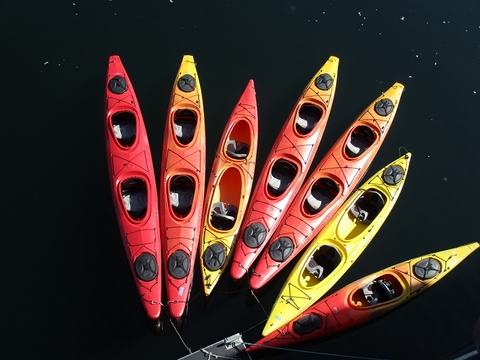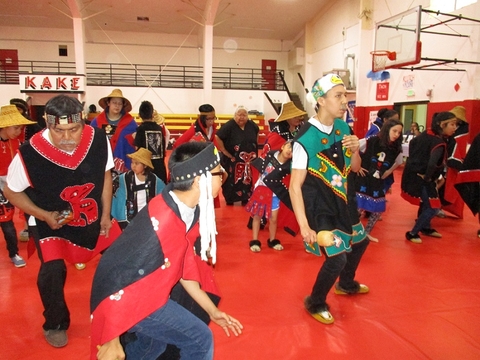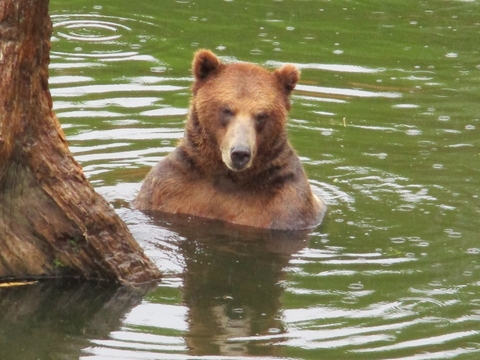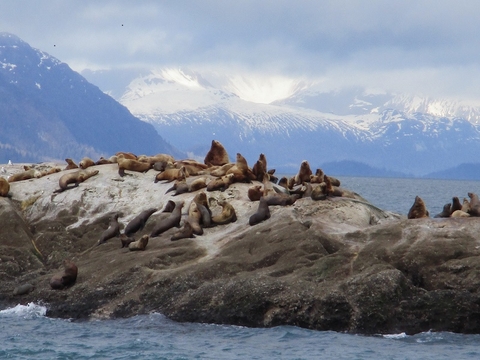Small ships sailing in southeastern Alaska ply shallower waters and slip quietly into remote coves and harbors that big ships simply can’t access. They call at off-the-beaten-path ports. They often get up-close to wildlife and marine life. Simply put, they sail “into the wild.”
Here are Travel Agent’s top "Into the Wild" experiences during our recent seven-night “Alaska’s Glacier Bay and Island Adventure” itinerary on Alaskan Dream Cruises’ 74-passenger Chichagof Dream.
Sea Lions & Whales
Throughout our cruise, we spotted multiple Stellar Sea Lions along our itinerary route. Mostly, they were sprawled over rocks adjacent to shorelines or on rocky isles. The males can reach up to 1,300 pounds, yet they scoot around on small flippers.
It was a thrill to observe this male sea lion group (shown in the photo below) sprawled over a rocky outcropping of South Marble Island within Glacier Bay National Park and Preserve. (Photo by Susan J. Young; all rights reserved)
As with Africa’s lions, Stellar Sea Lions have shoulders and necks that are disproportionately larger than the rest of their bodies. Each summer they gather in massive groups or in rookeries.
During our May cruise, we also spotted both humpback whales and orcas (in one case, an entire pod of orcas).
Whenever whales, sea otters, bears, mountain goats or seals were spotted by the ship's naturalists or bridge crew members, they announced the sightings over the ship's PA system and provided guidance as to where guests should look.
At times, the ship detoured a bit from its course or maneuvered closer to the wildlife to give guests the best views.
That said, some cruisers also saw wildlife "within civilization" -- not simply in the wild. For example, bald eagles were prolific in Sitka and could be spotted perched on utility poles, tall trees or dock pilings.
Also, on a shuttle bus ride through downtown Petersburg, passengers spotted a Sitka black-tailed deer adjacent to a home; it was just one block from the main commercial street.
Exclusive Orca Point Lodge Evening
Allen Marine, owner of Alaskan Dream Cruises, also owns and operates both whale-watching tour boats and Orca Point Lodge on Cold Island.
The lodge is a popular daytime stop as part of a whale watching shore excursion (for big-ship passengers boarding in Juneau). However, for all Alaskan Dream Cruises’ voyages, the company also sets up an exclusive, upgraded evening event at the remote lodge.
As Chichagof Dream anchored off Cold Island, we boarded a transfer ferry boat and were shuttled to a pier at the lodge. Upon arrival, we visited a covered structure with several marine-life touch tanks. Cruisers who so desired could touch sea stars, sea anemones or a hermit crab.
Guests then enjoyed drinks and savored the pristine wilderness views from either the inside dining room or the lodge’s outside deck. Some cruisers walked the beach, picking up rocks. Others eye-balled the Alaska products, crafts, gifts and souvenirs in the lodge's gift shop.
What's special? Besides the stunning views, we dined on prime rib, flame-grilled salmon and Alaskan king crab with drawn butter. Plus, the event offered guests many other Alaska specialties, salads, soup and many yummy desserts.
Crew members started a bonfire in front of the lodge and served "smores" to guests. Or, cruisers could roast their own marshmellows over the fire.
As the sun set, our group re-boarded the shuttle boat to return to Chichagof Dream, visible just a few hundred feet away. For many cruisers, this special evening event was one of the highlights of the cruise.
Kayaks & Motorized Water Craft
Chichagof Dream carries its own fleet of colorful kayaks that can accommodate one or two guests. The ship also has two nimble "DIBs," or Demaree Inflatable Boats.
Operated by skilled crew members, the DIBs -- rigid-bottom inflatables -- will transport guests close to shorelines (beaches, sheer rock faces and forested areas) as well as glaciers in Alaska's fjords.
On our specific cruise, these DIBs were deployed within Glacier Bay National Park and Preserve, in remote Saginaw Bay on northern Kuiu Island, within Tracy Arm, and elsewhere along Chichagof Dream's route. Often, they made wet landings with guests hopping out for hiking or beach walks.
Kayaking was set up by the crew in select locations along the route, such as within Saginaw Bay. Timing was based on sea conditions.
To make it easy and safe for loading/unloading of kayaks, Chichagof Dream has custom-built kayak launchers. In the photo below, kayaks are shown in the water, as viewed looking down from an upper deck. (Photo by Susan J. Young; all rights reserved.)

Our cruise on Chichagof Dream attracted a broad mix of passengers -- from Millennials to mature travelers in their 80s and 90s. Most guests were in their 40s-70s. Many were fit, others not.
Naturalists encouraged potential kayakers about the fun and ease of the experience, and were most willing to assist novices. Some guests on our cruise headed out kayaking for the first time.
Others knew how to kayak, but hadn't done it for many years. Several guests were passionate, experienced kayakers in search of their next adventure.
Important to note? All kayaking and DIBs outings were strictly voluntary. The crew wasn't pushy if a guest didn’t choose to go. Simply put, it was the guest's choice. Some travelers stayed onboard and just watched.
Kake & Tlingit Culture
An absolute delight? It can be described in one word: "Kake"
Situated on Alaska's Kupreanof Island, Kake is a small enclave of about 500 residents. About 70 percent of those are of native Tlingit descent.
Yes, the island has seen more prosperous times in the past -- when timber and seafood manufacturing were in high gear -- but the island residents' spirit remains strong.
As guests walked off our ship, they could see the abandoned Keku Cannery, with various buildings constructed between 1912 and 1940 for the Pacific salmon canning industry.
Fortunately, it's recently been designated as the Kake Cannery National Historic Landmark. The Tlingit community and the U.S. National Park Service are working to rehabilitate it and turn it into a hub for arts, culture and nature-based tourism, while retaining the old cannery's historic features.
Adjacent to the cannery, we boarded a school bus and headed out to see a master totem pole carver demonstrating his carving instruments. Then it was on (by bus or by hiking) to a seaside spot that's home to a 132-foot totem pole, described by locals as the world’s tallest.
Commissioned by the City of Kake and carved from one cedar tree in Haines, AK, it was displayed at the 1970 World’s Fair in Osaka, Japan. It was installed in Kake in 1971, and over time has faded, weathered with time and storms, and is now secured by cables.
Our Tlingit guide explained that the design incorporates symbols from Tlingit clans, as well as Tsimshian and Haida tribes. At its base, the totem pole depicts a strong man ripping a sea lion in half; frogs, salmon and orca images grace the pole, and an eagle is perched on top.
The highlight of our Kake tour, though, was a cultural/dance performance put on by local Tlingit residents at the Kake Community Hall & Gymnasium.
Outside a Tlingit elder who is a former U.S. marine and Korean War veteran, proudly greeted us in his colorful tribal regalia and displayed military-related memorabilia.

Inside, we sat on the gym’s tiered benches, while dozens of residents – toddlers to elders – danced into the gymnasium in their family's tribal -- and very colorful -- red, blue and green regalia. (Photo above by Susan J Young; all rights reserved).
Chanting and moving to the rhythm of a hand-held drum, they presented several dances before beckoning cruise visitors to join them on the dance floor. Many cruisers did, and it was a joyful celebration of immersion into a different culture.
Hiking Into the Wild
Throughout our southeastern Alaska itinerary, Chichagof Dream sailed in "waters less traveled" -- often without views of any other vessels, villages or towns.
So, if travelers love to get out and explore – walking through a temperate rainforest with a skilled guide, checking out the flora, birds and potential wildlife along the way, this kind of cruise is a great option.
Hikes, which were guided by the ship's onboard naturalists or a Tlingit guide, were set up almost every day, depending on weather. In fact, hiking was “built into” many destination experiences.
In an "educated guess," I'd say about 80-85 percent of guests headed out on every hiking option offered.
In Petersburg, a shuttle bus picked up passengers from our the ship and dropped them at the trail head for Hungry Point Trail, a quiet trail that bisects the town muskeg and offers mountain views. At times, black-tailed deer can be spotted along this trail.
When the hike concluded, the shuttle bus picked passengers up and either dropped them in downtown Petersburg or back at the ship.
During a call at Glacier Bay National Park and Preserve at Bartlett Cove, Gustavus, AK, cruisers went ashore and also hiked on either a long trail or a shorter one, depending on their interests and physical condition.
When they returned, two separate groups spoke enthusiastically and humorously about their big wildlife sightings -- in one case a red squirrel, and in another case, a porcupine sauntering along the trail.
On another day, after a visit to Marjorie Glacier, the ship headed for Reid Glacier, where the DIBs took guests close to the glacier and then headed for an adjacent beach, where guests stepped ashore for a beach walk.
Could be improved? I felt much more detail in advance was needed for guests about hike specifics or other options for the day ahead. The information provided in the nightly turn-down sheet about the next day's activities was too vague.
For example, it would be good to know if a morning hike is a quarter mile, two miles or even longer in distance, or whether the hike involves uphill climbing. It would also be helpful to know in advance that a shuttle bus will run back to the ship continuously between 3 to 5 p.m. from a certain spot.
People on vacation like to know what to expect. Fortunately, Alaskan Dream Cruises told Travel Agent that it is indeed working to add more detail in guests' written communications such as the information sheet (about the next day's activities) placed on guest beds during the nightly turn-down service.
Bears, Bears, Bears
Certainly, most cruisers say that spotting a bear in the wild is a “bucket list” travel experience. In Alaska, the chances are good.
Onboard Chichagof Dream, an enrichment lecturer gave a presentation on bears in Alaska, so guests knew what to expect. Did you know that black bears can actually be brown, reddish, black or even a silver-like color? It’s true.
As the small ship sailed through Tracy Arm Fjord, we spotted a black bear (with brown coloring) close to the water, along a sheer rock face. It was tearing apart barnacles for the tasty, salty treat inside.
What’s nifty about a small ship is that it can get close to such scenes -- much closer than bigger ships with a deeper draft.
We were instructed about the importance of being silent when wildlife were spotted. Thus, we didn't disturb the bear and could snap photos, observe its behavior and soak in the "eco-moment."
As the ship sailed on farther into Tracy Arm, there was another alert. Guests on our cruise were ecstatic as four more black bears were sighted, also picking through barnacles along the water. This group included a mother bear and three older cubs, both brown and black in coloring.
On previous cruises -- both big ship and small ship alike -- I've spotted bears in Glacier Bay, on a trail atop Juneau and along a mountain road outside Skagway. So guests have a decent chance of perhaps seeing a bear in the wild.
Still, if for any reason cruisers don't see wild bears but are spending a pre- or post-cruise stay in Sitka, there's a good option. They can simply head to the Fortress of the Bear, an orphaned bear rescue operation outside town.
It's a nonprofit attraction that's home to some gorgeous bears that visitors can safely view from above. See photo below (Photo by Susan J. Young. All rights reserved).

Parting Thoughts
Travel Agent sailed on Chichagof Dream’s seven-night voyage from Juneau to Sitka. It visited Glacier Bay, Frederick Sound, Tracy Arm, Saginaw Bay, Petersburg and Kake.
Other Alaskan Dream Cruises’ itineraries are operated on this and other ships in the fleet. Some voyages call at the same ports as listed above, while others sail into such destinations as Metlakatla/Misty Fjords, Skagway, Thorne Bay/Kasaan and Wrangell.
Small ship Alaska cruises give passengers a chance to hike, go kayaking, spot wildlife and marine life, and just soak in the 49th state's scenic beauty.
These voyages also deliver an authentic land experience -- with guests learning first-hand about Alaskan culture, lifestyle, heritage and the great outdoors from native Tlingits.
Simply put, for travelers with an explorer mindset, a small-ship cruise provides an easy, comfortable way to journey "into the wild."
Related Stories
Preview: Seven Seas Splendor’s First Summer Season
Crystal Ravel Christened in Budapest
